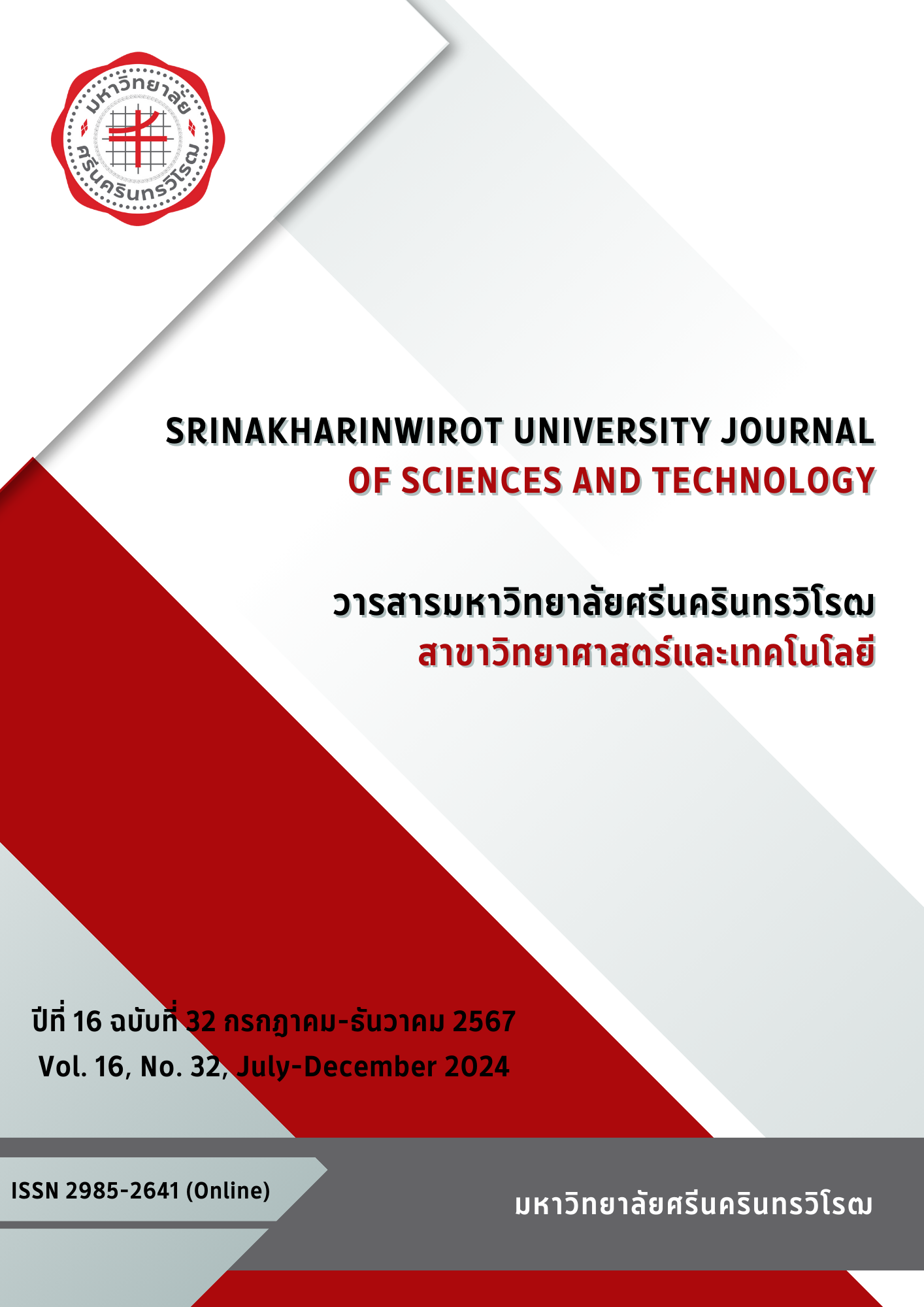การศึกษาสมบัติทางฟิสิกส์และเคมีของเส้นใยสับปะรดพันธุ์ปัตตาเวีย นางแลและภูแลในเขตจังหวัดเชียงราย
คำสำคัญ:
สับปะรดนางแล, สับปะรดภูแล, เส้นใยสับปะรด, สมบัติทางฟิสิกส์, สมบัติทางเคมีบทคัดย่อ
งานวิจัยนี้มีวัตถุประสงค์เพื่อศึกษาสมบัติทางฟิสิกส์และเคมีของเส้นใยจากใบสับปะรดพันธุ์ปัตตาเวีย นางแลและภูแล ในจังหวัดเชียงราย จากการผลิตเส้นใยด้วยวิธีเชิงกลจากนั้นนำเส้นใยที่ได้ไปทดสอบและวิเคราะห์สมบัติทางฟิสิกส์ เช่น ลักษณะผิว ความละเอียด ความทนต่อแรงดึง ความเหนียว และความยืดตัว เป็นต้น และสมบัติทางเคมี เช่น ธาตุประกอบและสารประกอบสำคัญของเส้นใย จากการวิจัยพบว่า เส้นใยสับปะรดปัตตาเวียและนางแลมีเส้นผ่านศูนย์กลาง 77.64±24.89 ไมโครเมตร และ 80.82±34.79 ไมโครเมตร ตามลำดับ ส่วนเส้นใยภูแลมีค่าประมาณ 67.32±22.96 ไมโครเมตร ผลการวิเคราะห์ความละเอียดของเส้นใยปัตตาเวีย นางแล และภูแลมีค่า 52 54 และ 48 ดีเนียร์ เมื่อทดสอบความเค้นดึง พบว่าเส้นใยสับปะรดปัตตาเวีย นางแล และภูแลมีค่า 317.38±102.91, 308.75±62.02 และ 244.65±139.68 เมกะปาสคาล ตามลำดับ ค่าความเหนียวเท่ากับ 4.42±0.52, 2.99±0.39 และ 4.58±1.02 กรัม/ดีเนียร์ ตามลำดับ และค่าความยืดตัว เท่ากับ 4.79±0.85, 4.76±0.45 และ 7.38±1.77% ตามลำดับ สำหรับผลการวิเคราะห์สมบัติทางเคมี พบว่าเส้นใยทั้งสามชนิดมีองค์ประกอบหลักเป็นธาตุคาร์บอนและออกซิเจน ซึ่งสอดคล้องกับผลการวิเคราะห์สารประกอบสำคัญของเส้นใย กล่าวคือ เส้นใยปัตตาเวียและนางแลมีปริมาณเซลลูโลส 47.62 และ 42.86% ตามลำดับ ในขณะที่เส้นใยภูแลมี 35.10% เมื่อวิเคราะห์ปริมาณเฮมิเซลลูโลส พบว่าเส้นใยภูแลมีปริมาณมากที่สุด 36.73% ส่วนปัตตาเวียและนางแลมีค่าใกล้เคียงกัน คือ 23.81 และ 22.86% ตามลำดับ สำหรับปริมาณลิกนินในเส้นใยทั้ง 3 ชนิด มีปริมาณใกล้เคียงกัน คือ ปัตตาเวีย 20.00% นางแล 17.14% และภูแล 19.35% ผลการวิจัยสรุปได้ว่า เส้นใยทั้งสามชนิดมีสมบัติทางฟิสิกส์และเคมี ที่สามารถใช้เป็นเส้นใยสำหรับสิ่งทอได้ โดยเฉพาะอย่างยิ่งเส้นใยภูแลที่มีเส้นเล็ก เหนียวและยืดหยุ่นได้ดี ทำให้เมื่อผลิตเป็นสิ่งทอจะทำให้ผู้สวมใส่รู้สึกสบาย นุ่มและเบา
Downloads
เอกสารอ้างอิง
Khambunreang, J. (2019). Pineapple fiber paper, local products “NangLae”. Retrieved from https://www.chiangmainews.co.th/page/archives/931679/
Kantarod, P., and Boonmee, N. (2023). From pineapple leaves to weaving fibers Linking tourism and lifestyle. Retrieved from https://www.cmthainews.com/archives/25383
Prachakul, U., Kumsook, K., and Musikapan, R. (2019). The Study and development of silk and pineapple fiber textiles for lifestyle fashion products: A Case study of silk weavers group, baan ta ruea, nawa district, nakhon phanom province. Proceedings of the 9th national SMARTS conference: SMARTS IX, pp. 189-202.
Mungkhetklang, K., and Charoenlarp, K. (2020). Pretreatment of pineapple fibers from mechanical separation by water and chemicals. UTK Research Journal, 14(2), 67-77.
Surawattanawises, W., Chonsakorn, S., and Mongkholrattanasit, R. (2017). Physical properties of pineapple fiber and mechanical testing for scrub pads application. SDU Res. J., 10(3), 87-103.
Amornsakchai, T., and Kengkhetkit, N. (2014). Pineapple leaf: Source of natural fiber that should not be ignored. Srinakharinwirot Science Journal, 30(2), 1-10.
Tamthong, W., Kraisuwan, S., and Piromthamsiri, K. (2021). The effects of corn varieties, layers of corn husks and fiber extraction methods on chemical and mechanical properties of corn husk fibers. Srinakharinwirot University Journal of Sciences and Technology, 13(26), 91-105. https://ph02.tci-thaijo.org/index.php/swujournal/article/view/246245
Mansor, A. M., Lim, J. S., Ani, F. N., Hashim, H., and Ho, W. S. (2019). Characteristics of cellulose, hemicellulose and lignin of md2 pineapple biomass. Chemical Engineering Transactions, 72, 79-84.
Mbugua, G. W. (2009). Determination of fibre properties of Agave Americana leaves as a textile fibre from Mbaruk, Nakuru District [Unpublished master’s thesis]. Kenyatta.
Pereira P. H. F., Arantes V., Pereira B., Ornaghi Jr., H. L., de Oliveira D. M., Santagneli, S. H., and Cioffi, M. O. H. (2022). Effect of the chemical treatment sequence on pineapple peel fiber: Chemical composition and thermal degradation behavior. Cellulose, 29, 8587-8598.
Fidelis M. E. A., Pereira T. V. C., Gomes O. F. M., Silva F. A., and Filho R. D. T. (2013). The Effect of fiber morphology on the tensile strength of natural fibers. Journal of Materials Research and Technology, 2(2), 149-157.
George, J., Bhagawan, S. S., Prabhakaran, N., and Thomas, S. (1995). Short pineapple-leaf-reinforces low-density polyethylene composites. Journal of Applied Polymer Science, 57, 843-864.
Arib, R. M. N., Sapuan, S. M., Ahmad, M. M. H. M., Paridah, M. T., and Khairul Zaman, H. M. D. (2006). Mechanical properties of pineapple leaf fibre reinforced polypropylene composites. Materials and Design, 27, 391-396.
Pardo, M. E. S., Cassellis, M. E. R., Escobedo, R. M., and García, E. J. (2014). Chemical Characterisation of the Industrial Residues of the Pineapple (Ananas comosus). Journal of Agricultural Chemistry and Environment, 3, 53-56.
Sweygers, N., Depuydt, D. E. C., Eyley, S., Thielemans, W., Mosleh, Y., Ivens, J., Dewil, R., Appels, L., and Van Vuure, A. W. (2022). Prediction of the equilibrium moisture content based on the chemical composition and crystallinity of natural fibres. Industrial Crops and Products, 186, Article number 115187.
Zhang, S. Y., Fei, B. H., Yu, Y., Cheng, H. T., and Wang, C. G. (2013). Effect of the amount of lignin on tensile properties of single wood fibers. Forest Science and Practice, 15, 56-60.
Rana, S., Pichandi, S., Parveen, S., and Fangueiro, R. (2014). Natural plant fibers: Production, processing, properties and their sustainability parameters. In S. Muthu (Ed.) Roadmap to Sustainable Textiles and Clothing. Textile Science and Clothing Technology. Springer, Singapore.
ดาวน์โหลด
เผยแพร่แล้ว
รูปแบบการอ้างอิง
ฉบับ
ประเภทบทความ
สัญญาอนุญาต
ลิขสิทธิ์ (c) 2024 วารสารมหาวิทยาลัยศรีนครินทรวิโรฒ สาขาวิทยาศาสตร์และเทคโนโลยี

อนุญาตภายใต้เงื่อนไข Creative Commons Attribution-NonCommercial-NoDerivatives 4.0 International License.
วารสารมหาวิทยาลัยศรีนครินทรวิโรฒ สาขาวิทยาศาสตร์และเทคโนโลยี อยู่ภายใต้การอนุญาต Creative Commons Attribution-NonCommercial-NoDerivs 4.0 International (CC-BY-NC-ND 4.0) เว้นแต่จะระบุไว้เป็นอย่างอื่น โปรดอ่านหน้านโยบายของวารสารสำหรับข้อมูลเพิ่มเติมเกี่ยวกับการเข้าถึงแบบเปิด ลิขสิทธิ์ และการอนุญาต



